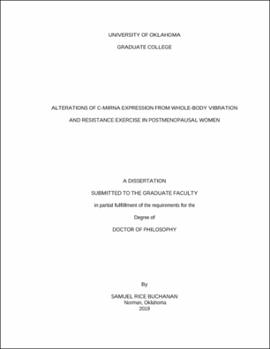| dc.description.abstract | INTRODUCTION: Previous research has examined the effects of exercise on circulating miRNA (c-miRNA) expression. C-miRNAs have been associated with exercise-induced adaptations for skeletal muscle hypertrophy and aerobic capacity in humans, and angiogenesis in rats. Most studies evaluating miRNA expression post-exercise have utilized either running, cycling, or resistance training, but no studies were found where whole-body vibration was used in humans. Furthermore, evaluation of miRNAs in the context of exercise and aging is also sparse in evidence in human populations, especially postmenopausal women. Evaluating alterations in the expression of c-miRNA may provide deeper insight into the positive effects of exercise in the attenuation of the negative effects of aging. PURPOSE: The primary purpose of this study was to characterize the effects of acute bouts of resistance exercise and whole-body vibration on expression of selected c-miRNAs in postmenopausal women aged 65-85 years. The secondary purpose of this study was to determine if correlations exist between baseline c-miRNAs and muscle strength and bone characteristics. METHODS: Ten community-dwelling, postmenopausal women aged 65-85 were recruited for the study. This within-subjects randomized crossover study design compared the relative expression changes of c-miRNA from a bout of resistance exercise and a bout of whole-body vibration. Dual x-ray absorptiometry (DXA) was used to measure body composition and areal bone mineral density (BMD) of the total body, AP lumbar spine, and dual proximal femur. Peripheral quantitative computed tomography (pQCT) was used to measure volumetric values of BMD at the 4%, 38%, and 66% sites. Participants performed resistance exercises in the following order: leg press, shoulder press, lat pulldown, leg extension, and hip adduction. There were three sets of 10 repetitions per exercise at 70% of 1RM with 2-3 min of rest between sets and exercises. Participants performed vibration training on the Vibraflex Vibration Platform. Each of 5 bouts were performed for one min at a 20 Hz frequency with a 3.38 mm peak-to-peak displacement and 1 min of rest between bouts. A blood sample of 7.5 ml was collected via venipuncture by a registered phlebotomist. Baseline samples were collected between 8:00 and 9:00 a.m. after an 8h overnight fast and again immediately-post, 60 min, 24 hrs, and 48 hrs after exercise to measure c-miRNA. After each draw, two hematocrit tubes were filled from the serum separator tubes (SST) for measurement of hematocrit (HCT) and plasma volume shifts. Samples were aliquoted and frozen at -84 °C until shipped for analysis. MicroRNA quantification was performed by TAmiRNA Vienna, Austria for miR-21a-5p, -23a-3p, -133a-3p, -148a-3p. ANALYSIS: Statistical analyses were performed using IBM SPSS Statistics (SPSS Inc., Chicago, IL), version 24. Normality of dependent variables was assessed via Shapiro-Wilk tests. Non-normal distributions were assessed with the Kruskal-Wallis test and Mann-Whitney U tests. A two-way mixed-model repeated measures ANOVA [modality × time] was used to assess changes across time between the two exercise modalities. For significant modality × time interactions, one-way ANOVAs across time for each modality with Bonferroni corrections was used for post-hoc pairwise comparisons. Pearson’s r and Spearman’s rho rank correlation coefficient were utilized to determine associations between microRNAs and muscle strength and bone variables for normal and non-normal data, respectively. The alpha was set at p≤0.05. RESULTS: Nine of 10 participants were highly active based on their IPAQ scores, none presented with osteoporosis at any site, and two were considered sarcopenic based on one EWGSOP definition. There was a significant interaction for miR-21 (p=0.019) where the miRNA decreased in expression from 60p to 24h after WBV that did not occur after RE. There were also multiple negative correlations between miRNAs and bone status variables from DXA and pQCT that were logical based on miRNAs predicted targets, but those correlations did not occur on both testing days. TRAP5b concentrations significantly decreased 24h after exercise (p<0.01) even after correcting for plasma volume shifts (p<0.01). CONCLUSIONS: Both resistance exercise and WBV conditions suppressed TRAP5b concentrations by 24h. The miRNAs chosen for this study were expressed well in all participants and across testing timepoints. There was wide variability in expression and responses to exercise that may have been influenced by uncontrollable environmental factors. Though pre-exercise miRNA expression was inconsistent, the significant correlations between miRNAs that negatively affect bone and bone status that were found had the expected negative associations. TRAP5b absolute changes were not related to miRNA expression changes. Future studies investigating multiple exercise modalities should take care to control for as many environmental factors as possible. | en_US |

